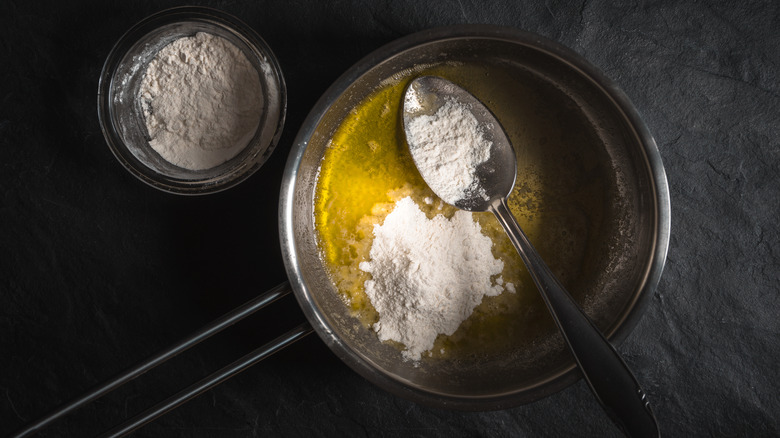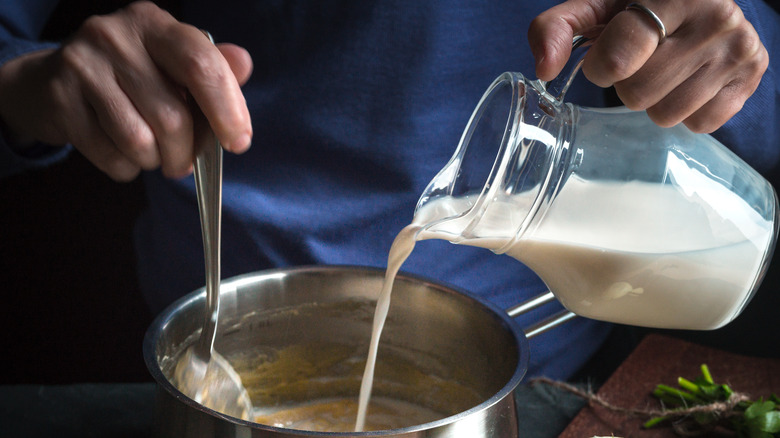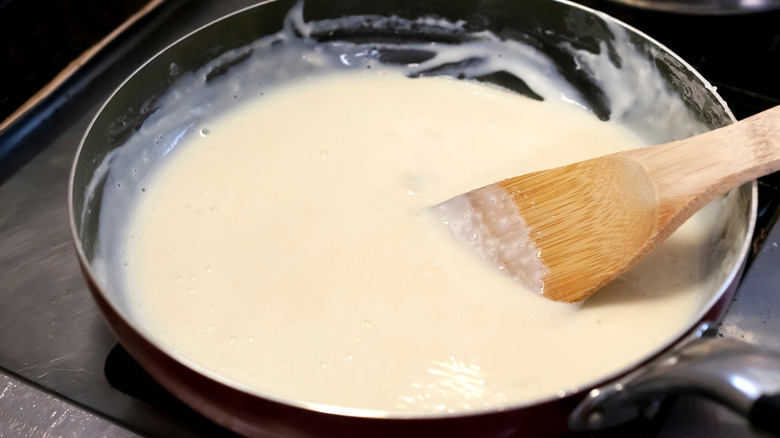Why The Color Of Your Roux Matters
No one knows roux quite like acclaimed Creole chef Leah Chase, who says that: "Without it, a lot of sauces would be just like water on a plate." While roux is technically any equal combination of fat and starch, butter and flour are commonly used. Roux is used as a thickener and is a flavor base for a myriad of recipes. Roux thickens soups and casseroles and can save thin, runny sauces.
The flavor of roux comes from the length of time that the fat and starch are cooked together. Cook's Illustrated describes the color of roux changing as it cooks from "white to blonde to peanut butter — and even darker." The darker the color, the more flavorful — a nutty or toasted flavor, according to The Washington Post. Yet, the darker the roux the less thickening power, warns the Post. From a scientific standpoint, the starch in flour is what enables thickening. But, as the flour heats up, the starch breaks down, so the longer the cook time, the less it can thicken.
This is why the color of roux matters, but how do you know what color you need for a specific recipe?
White roux is thickest and mild
A light color roux, known as "white roux" is cooked just long enough to cook out the taste of raw flour, about 2-4 minutes. This short cooking time does not cook the fat so the flavor will be minimal. To make the white roux, place butter in a heated pan and once it's melted, sprinkle in equal parts flour, explains Food Network. This is a one-to-one ratio. Stir the flour into the butter for no longer than five minutes, until "puffy."
This type of roux is perfect for creamy, white bechamél, says The Kitchn. Bechamél is the "backbone" of many cream-based dishes like macaroni and cheese and sausage gravy. Milk-based sauces are best used with white roux as opposed to darker roux because the flavor is "neutral," suggests MasterClass. If you're not using it for white sauces, then use it to thicken creamy soups and chunky chowders.
Blonde roux has a nutty flavor
Blonde roux is the next color gradient in roux development. Blonde roux has been cooked until it starts to smell nutty. Epicurious likens its appearance to peanut butter. This can happen anywhere between five to seven minutes of cook time. After you've proceeded as above, keep stirring, suggests Food Network. This roux is still on the lighter side, so the thickening agents are still intact, it just has a nuttier flavor than white roux. MasterClass says to use this to thicken sauces and soups. The darker color won't affect them but would alter the appearance of a white sauce like bechamel.
French velouté, a mother sauce of French cuisine, uses the blonde roux for its dishes. Velouté is reserved for sauces using chicken stock as opposed to milk. After cooking the butter and flour to your desired "blonde" color, slowly whisk in warmed chicken stock and keep whisking until smooth.
Thin dark roux is packed with flavor
Roux starts browning after the blonde stage. Colors range from medium to dark brown, writes Epicurious, and can take as long as 15-45 minutes. The longer you cook, the darker the roux becomes. The flavor develops along the way too. The nutty flavor of a medium-brown roux can turn into a "chocolate or tobacco" flavor when it reaches a dark-brown hue.
The Washington Post warns that you must whisk continuously to prevent burning. Remember, roux cooked this long has much less thickening power. This is not the color you want for sauces. Instead, MasterClass suggests using it in cajun and Creole cooking. Dishes like gumbo and jambalaya get their flavor from the rich flavors the dark roux has developed from its long cooking time. That being said, Leah Chase does not recommend using butter for a gumbo roux because it doesn't have a high enough smoke point, so she recommends vegetable oil instead.
A rich stew shouldn't be thick or "gloppy", encourages Cook's Illustrated. Watch the color of your roux to make sure your dish is the right consistency.



